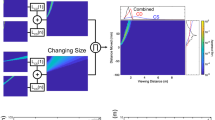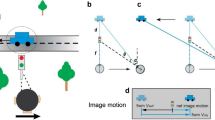Abstract
THE most meaningful events ecologically, including the motion of objects, occur in relation to or on surfaces1. We run along the ground, cars travel on roads, balls roll across lawns, and so on. Even though there are other motions, such as flying of birds, it is likely that motion along surfaces is more frequent and more significant biologically. To examine whether events occurring in relation to surfaces have a preferred status in terms of visual representation, we asked whether the phenomenon of apparent motion would show a preference for motion attached to surfaces. We used a competitive three-dimensional motion paradigm2 and found that there is a preference to see motion between tokens placed within the same disparity as opposed to different planes. Supporting our surface-layout hypothesis, the effect of disparity was eliminated either by slanting the tokens so that they were all seen within the same surface plane or by inserting a single slanted background surface upon which the tokens could rest. Additionally, a highly curved stereoscopic surface led to the perception of a more circuitous motion path defined by that surface, instead of the shortest path in three-dimensional space.
This is a preview of subscription content, access via your institution
Access options
Subscribe to this journal
Receive 51 print issues and online access
$199.00 per year
only $3.90 per issue
Buy this article
- Purchase on Springer Link
- Instant access to full article PDF
Prices may be subject to local taxes which are calculated during checkout
Similar content being viewed by others
References
Gibson, J. J. The Ecological Approach to Visual Perception (Houghton Mifflin, Boston, 1979).
Ramachandran, V. S. & Anstis, S. M. Nature 304, 529–531 (1983).
Burt, P. & Sperling, G. Psychol. Rev. 88, 171–195 (1981).
Finney, D. J. Probit Analysis (Cambridge Univ. Press, UK, 1971).
Green, M. & Odom, J. V. Science 233, 1427–1429 (1986).
Harris, J. P. & Gregory, R. L. Perception 2, 235–247 (1973).
Ullman, S. The Interpretation of Visual Motion (MIT Press, Cambridge, MA, 1979).
Mutch, K., Smith, I. M. & Yonas, A. Perception 12, 305–312 (1983).
Attneave, F. & Block, G. Percept. Psychophys. 12, 301–307 (1973).
Foster, D. H. Bio. Cyber. 18, 81–89 (1975).
Carlton, E. H. & Shepard, R. N. J. math. Psychol. 34, 127–188 (1990).
Marr, D. Vision (Freeman, San Fancisco, 1982).
Shimojo, S. & Nakayama, K. Perception 19, 285–299 (1990).
Author information
Authors and Affiliations
Rights and permissions
About this article
Cite this article
He, Z., Nakayama, K. Apparent motion determined by surface layout not by disparity or three-dimensional distance. Nature 367, 173–175 (1994). https://doi.org/10.1038/367173a0
Received:
Accepted:
Issue Date:
DOI: https://doi.org/10.1038/367173a0
This article is cited by
-
Terrain influences the accurate judgement of distance
Nature (1998)
-
Perceived visual speed constrained by image segmentation
Nature (1996)
-
Seeing motion behind occluders
Nature (1995)
Comments
By submitting a comment you agree to abide by our Terms and Community Guidelines. If you find something abusive or that does not comply with our terms or guidelines please flag it as inappropriate.



